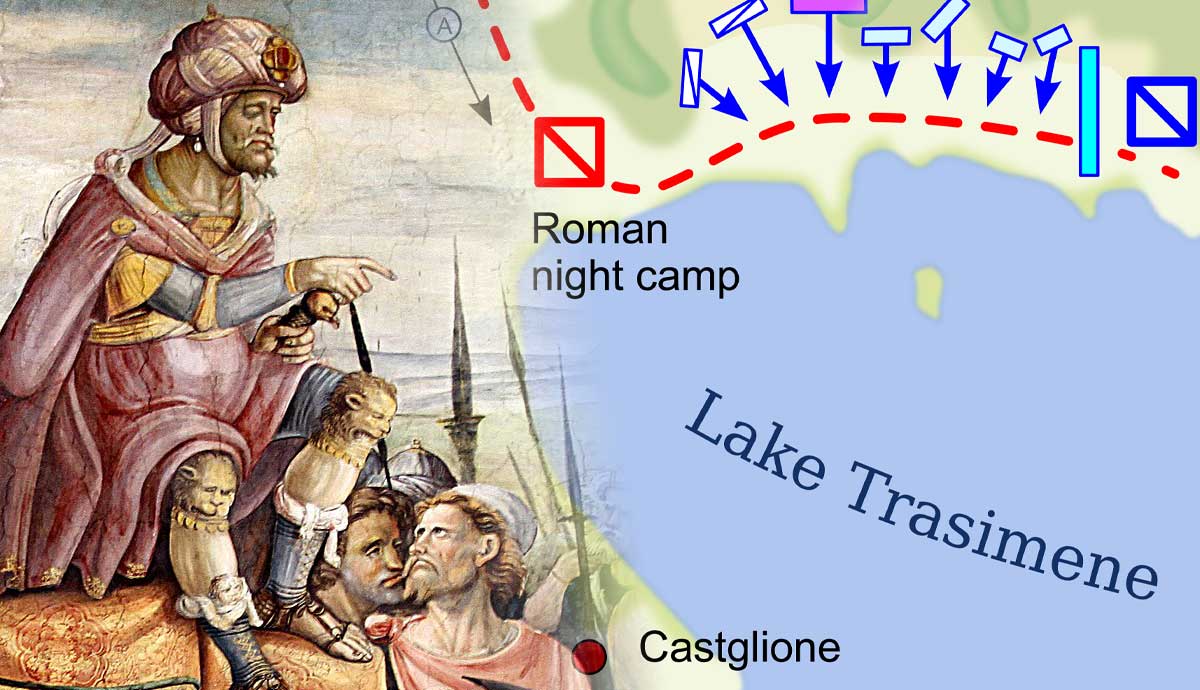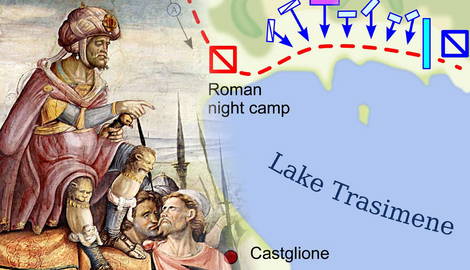
In 218 BCE, war broke out between Rome and Carthage, the two largest powers in the Western Mediterranean. What Rome expected to be a quick and easy war turned out to be a long, bitter, and costly conflict that would claim the lives of many brave Romans. The Romans suffered several major defeats during the opening stages of the war at the hands of the brilliant Carthaginian general Hannibal Barca. One such defeat was the massacre at Lake Trasimene.
Before Trasimene: Hannibal Crossing the Alps

The Romans expected to fight the war not on Italian soil but in Carthage’s holding in Spain and North Africa. Hannibal Barca, however, did what many believed to be impossible. He gathered his army in Iberia (modern-day Spain and Portugal), numbering 50,000 infantry, 9,000 cavalry, and 37 elephants, and proceeded to cross the Pyrenees and then the impregnable Alps in late Autumn 218 BCE.
It was a grueling journey that cost Hannibal dearly in manpower. He suffered terrible losses in battles and ambushes by hostile tribes, and even more men were lost due to the devastating weather conditions. When Hannibal arrived on the other side of the Alps, he had a mere 20,000 infantry, 6,000 cavalry, and only a small number of elephants left. Despite his losses, Hannibal caught the Romans completely by surprise, arriving in their backyard with an army ready to fight.
First Blood: The Battle of Ticinus

When Publius Cornelius Scipio, one of Rome’s two consuls and military leaders, learned of Hannibal’s arrival in Italy, he assembled his forces and marched out to confront the invading army. The two opposing forces set up their camps close to each other on the right bank of the Ticinus River. At the start of the next day, both armies sent out scouting parties for reconnaissance to learn the strength of the opposing army. The Carthaginian scouts consisted of Hannibal’s Iberian and Libyan heavy cavalry and his elite Numidian light cavalry. Scipio’s Roman force was a mixed force of Gallic and Roman horsemen supported by javelin-armed light infantry called velites.
When the two forces met, the Romans sent forth their velites to engage the enemy cavalry with their javelins. The Carthaginian heavy cavalry, however, charged down at the Roman light infantry, which barely cast a javelin, and drove them back onto their own ranks. The Roman cavalry, in response, charged the Carthaginian heavy horsemen. The cavalry on both sides engaged in a violent melee that got so fierce that many horsemen dismounted and fought on foot. The stalemate was finally broken when Hannibal’s Numidians rode around the Roman position, outflanking them and attacking from the rear. The Romans broke and fled, taking refuge in their fortified camp near Placentia.
Scipio was wounded and would have perished in the battle had it not been for the bravery of his 16-year-old son, also named Publius Cornelius Scipio, who saved his life. The defeat shocked the Romans, and the senate immediately recalled the army on its way to Africa, under Tiberius Sempronius Longus, to defend Italy. In the greater schemes of the Second Punic War, it was a minor battle, but it was a taste of things to come.
Trebbia: Battle on the Icy River

When Sempronius arrived to reinforce Scipio, he was eager to battle the Carthaginians despite Scipio advocating for caution. Hannibal, however, took advantage of Sempronius’ impetuousness to lure him and his army into unfavorable battle conditions. The Romans had to cross the freezing Trebbia River in the heart of the winter to meet the Carthaginians, kept warm by their fires, on the opposite side:
“To make matters worse, men and horses alike had been hurriedly sent forward, without any food, without any protection against the cold, so they had no heat in them and the chilling blasts from the river made the cold still more severe as they approached it in their pursuit of the Numidians. But when they entered the water which had been swollen by the night’s rain and was then breast high, their limbs became stiff with cold, and when they emerged on the other side, they had hardly strength to hold their weapons; they began to grow faint from fatigue and as the day wore on, from hunger.” (Livy 21.54.8-9)
When the two armies met in the melee, Hannibal sprang yet another trap that he had set up the day before. He had hidden 2,000 handpicked troops in a dry riverbed, which sprang from their position and attacked the Romans from behind while the cavalry attacked their flanks, winning a resounding victory over the Romans.
The Marsh Crossing

The Carthaginian general had proven himself an enemy not to be taken lightly, having defeated two Roman consuls in a matter of a few weeks. His victories against Rome also convinced the Gauls to support his cause, and his army swelled as Gallic warriors flocked to his banner.
The senate responded by sending two large armies north to block Hannibal’s advance into central Italy. The idea was that whichever of the two armies Hannibal encountered would monitor his advance until the other could arrive to support them, effectively trapping Hannibal between the two armies. Hannibal, however, pulled the wool over Roman eyes by once again doing what many thought impossible. Hannibal marched his army through a marsh that most people believed could not be crossed. It was a difficult crossing, and many men and animals lost their lives. Hannibal himself suffered a severe eye infection, which cost him an eye. Despite these losses, Hannibal was able to outmaneuver the two Roman armies and marched past the army under the command of Gaius Flaminius into Etruria (modern-day Tuscany) completely unnoticed.
The Battle of Lake Trasimene

Once in Tuscany, Hannibal let loose his troops, who raided and pillaged the countryside. This was a strategic move that forced the nearby army of Flaminius to respond. Flaminius gathered his forces and marched out in the hopes of confronting Hannibal rather than waiting for the reinforcing army to arrive. Polybius tells us that once again, the Romans expected an easy victory and were thus eager to engage the Carthaginians:
“…bent only on falling in with the enemy, as though certain victory awaited him. For he had managed to inspire the people with such confident expectations, that the unarmed citizens who followed his camp in hope of booty, bringing chains and fetters and all such gear, were more numerous than the soldiers themselves.” (Polybius, Histories, 3.82).
Hannibal kept his army just out of reach of the pursuing Flaminius, giving the impression that the Carthaginians were fleeing before them. The Romans were thus even more eager to catch up with them. When Hannibal reached the northern shore of Lake Trasimene, he deemed the place the perfect setting for an ambush: a narrow road that ran between the hills and the waters of the lake.

Early the next morning, at the break of dawn, Flaminius hurried his army of 25,000 out of camp, hoping to catch the Carthaginians off guard. A thick mist blanketed the lake shore, shrouding the area in poor visibility. Furthermore, in his rush to catch Hannibal, Flaminius made little effort to scout the road ahead. Flaminius was leading his column of soldiers along the narrow path between the lake shore and the hills when suddenly they heard trumpets, followed by the terrifying war cries of thousands of warriors piercing the mist. Africans, Iberians, and Gauls rushed down the hills and crashed into the Roman column while the Carthaginian cavalry attacked the rear guard, cutting off the retreat:
“Flaminius was taken completely by surprise: the mist was so thick, and so many of the enemy were charging down from the upper ground, that not only were the centurions and tribunes unable to relieve any part of the line, but they were unable to get any clear idea of what was going on. They were attacked simultaneously on the front, rear, and both flanks.” (Polybius, Histories, 3.84)

What followed was a massacre. The Roman army was in marching formation, completely unprepared for battle. The soldiers were trapped between the lake, the hills, and the enemy. Those who were not cut down where they stood were forced into the lake. Many drowned under the weight of their armor, while others begged their comrades to run them through so that the enemy would not. The rest were killed by the Carthaginian cavalry who followed them into the water:
“But those who were caught in the defile between the lake and the cliff perished in a shameful, or rather a most miserable, manner: for being thrust into the lake, some in their frantic terror endeavored to swim with their armor on, and presently sank and were drowned; while the greater number, wading as far as they could into the lake, remained there with their heads above water; and when the cavalry rode in after them, and certain death stared them in the face, they raised their hands and begged for quarter, offering to surrender, and using every imaginary appeal for mercy; but were finally despatched by the enemy, or, in some cases, begged the favor of the fatal blow from their friends, or inflicted it on themselves.” (Polybius, Histories, 3.84)

Polybius tells us that more than 15,000 Romans died in the battle. Among these was Flaminius himself. A group of 6,000 Romans in the vanguard of the column were able to cut their way through the Carthaginians. When they finally reached the safety of the hilltop and the mist had cleared, they looked back at the battlefield and only then grasped the full extent of the disaster that had unfolded. Rome had yet again suffered a devastating defeat at the hands of Hannibal. These 6,000 men took shelter in a small town close by. The next day, Hannibal surrounded the town with his light infantry and cavalry. Realizing the hopelessness of the situation, the 6,000 Romans surrendered.
Hannibal’s success was followed up with yet another victory over the Romans shortly after the Trasimene disaster. The second Roman army sent their 4,000 cavalry ahead to support Flaminius’ forces. Hannibal’s cavalry and light infantry were able to catch them off guard and killed about 2,000 of them, and the remainder were captured the next day.
Battle of Trasimene: Conclusion

Trasimene was a master class in ambuscades that highlighted Hannibal’s military genius and strategic superiority. Ambushes are common in warfare between small groups of soldiers, but the scale of the ambush at Trasimene was unparalleled as Hannibal had managed to conceal an entire army of 50,000 men right under the noses of the Romans. The ambush was extremely effective, leaving 60% of the entire Roman army dead on the field of battle. Many more were captured, and even the 6,000 who did manage to escape the slaughter were captured the next day. The Carthaginian losses were minimal. Polybius states that only 1,500 Carthaginians died, the majority of whom were Gauls. Livy gives a higher number of 2,500. The battle is considered one of Hannibal Barca’s three great victories over the Romans, alongside Trebbia and his masterpiece at Cannae.
The tide of the war would only turn when the Romans stopped fighting Hannibal in Italy and took the war to Carthage’s home turf. The decisive victory would come at the Battle of Zama in 202 BCE.










